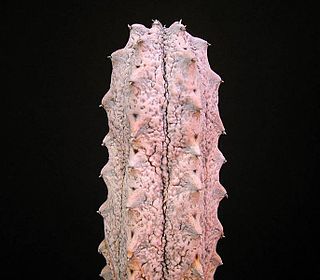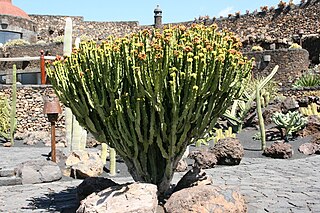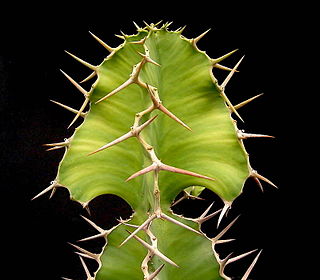
Euphorbia is a very large and diverse genus of flowering plants, commonly called spurge, in the spurge family (Euphorbiaceae). "Euphorbia" is sometimes used in ordinary English to collectively refer to all members of Euphorbiaceae, not just to members of the genus. Some euphorbias are commercially widely available, such as poinsettias at Christmas. Some are commonly cultivated as ornamentals, or collected and highly valued for the aesthetic appearance of their unique floral structures, such as the crown of thorns plant. Euphorbias from the deserts of Southern Africa and Madagascar have evolved physical characteristics and forms similar to cacti of North and South America, so they are often incorrectly referred to as cacti. Some are used as ornamentals in landscaping, because of beautiful or striking overall forms, and drought and heat tolerance.

Euphorbia mellifera, the Canary spurge or honey spurge, is a species of flowering plant in the spurge family Euphorbiaceae, native to Madeira and the Canary Islands. It is an evergreen shrub or tree growing to 2.5 m (8.2 ft) tall and broad, with narrow leaves up to 20 cm (8 in) long. In spring it produces brown, honey-scented flowers.

Joseph Marie Henry Alfred Perrier de la Bâthie was a French botanist who specialized in the plants of Madagascar.
Susan Carter Holmes is a botanist and taxonomist at the Royal Botanic Gardens, Kew. She discovered and catalogued more than 200 plants of the family Euphorbiaceae, particularly of the succulent East African members of the genera Euphorbia and Monadenium, as well as about 20 Aloe species. All plants and articles are published under her maiden-name Susan Carter.
Marlothiella gummifera is a species of flowering plant in the family Apiaceae, and the only species in the monotypic genus Marlothiella. It is endemic to Namibia, where its natural habitats are rocky areas and cold desert.

Euphorbia abdelkuri is a species of plant in the family Euphorbiaceae. It is endemic to Abd al Kuri, an island south of Yemen. Its natural habitat is rocky areas. The Latex of the plant is toxic.

Euphorbia leuconeura is a species of flowering plant in the family Euphorbiaceae. Its common name is Madagascar jewel. It is endemic to Madagascar where its natural habitat is forest undergrowth in rocky areas. It can grow to a height of 1.8 m (6 ft), as a branching small tree, and propagates by shooting its seeds several feet into the air. It is threatened by habitat loss.

The Euphorbiaceae, the spurge family, are a large family of flowering plants. In common English, they are sometimes called euphorbias, which is also the name of a genus in the family. Most spurges such as Euphorbia paralias are herbs, but some, especially in the tropics, are shrubs or trees, such as Hevea brasiliensis. Some, such as Euphorbia canariensis, are succulent and resemble cacti because of convergent evolution. This family occurs mainly in the tropics, with the majority of the species in the Indo-Malayan region and tropical America a strong second. A large variety occurs in tropical Africa, but they are not as abundant or varied as in the two other tropical regions. However, the Euphorbiaceae also have many species in nontropical areas such as the Mediterranean Basin, the Middle East, South Africa, and the Southern United States.

Euphorbia balsamifera is a flowering plant in the spurge family Euphorbiaceae. It is distributed in the Canary Islands and the western Sahara. It is the vegetable symbol of the island of Lanzarote. Euphorbia adenensis has been treated as a subspecies of this species.

Euphorbia grantii is a species of succulent plant in the family Euphorbiaceae.

Euphorbia hirta is a pantropical weed, originating from the tropical regions of the Americas. It is a hairy herb that grows in open grasslands, roadsides and pathways. It is widely used in traditional herbal medicine across many cultures, particularly for asthma, skin ailments, and hypertension. It is also consumed in herbal tea form as folk medicine for fevers in the Philippines, particularly for dengue fever and malaria.

Euphorbia cornigera is a species of flowering plant in the Euphorbiaceae family. It is referred to by the common name horned spurge and is native to Bhutan. It is a rhizomatous herbaceous perennial growing to 75 cm (30 in) tall, rarely 1 m, with narrow green leaves with a pale green spine. Acid yellow flowerheads (cyathia) are borne in summer.

Euphorbia abyssinica, commonly known as the desert candle or candelabra spurge, is a species of plant in the family Euphorbiaceae. E. abyssinica is endemic to Ethiopia, Somalia, Sudan and Eritrea. It was first described in 1791, by the German botanist Johann Friedrich Gmelin. In its native habitat, it can grow up to 10 m (33 ft) tall. The woody stem is used for firewood and as timber in roofing, furniture and other items, and the sap is used in traditional medicine. It is also cultivated as an ornamental house plant.
François Pellegrin was a French botanist, who specialised in the plants of tropical Africa.
Protea convexa, also known as large-leaf sugarbush, is a rare flowering shrub in the genus Protea of the family Proteaceae, which is endemic to the southwestern Cape Region of South Africa.

Euphorbia bupleurifolia, commonly known as cycad spurge or pine cone plant, is a species of plant in the family Euphorbiaceae.

Euphorbia groenewaldii is a species of flowering plant in the family Euphorbiaceae native to southern Africa. It is listed as endemic to and Critically Endangered in South Africa due to habitat destruction and overcollection. Kew's Plants of the World Online also lists it as native to Mozambique.

Euphorbia breviarticulata is a species of flowering plant in the family Euphorbiaceae. Euphorbia breviarticulata was described by Ferdinand Albin Pax and published in Botanische Jahrbücher für Systematik, Pflanzengeschichte und Pflanzengeographie 34: 84. 1904.
Euphorbia alsiniflora, is a species of flowering plant, belonging to the family Euphorbiaceae. It is native to Australia in the Northern Territory and Queensland.
Krukoviella is a monotypic genus of flowering plants belonging to the family Ochnaceae. It has one synonym PlanchonellaTiegh. The only species is Krukoviella disticha(Tiegh.) Dwyer














